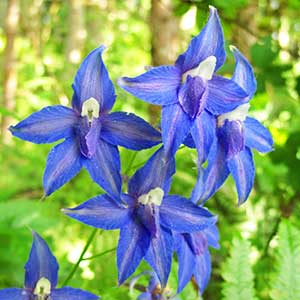Delphinium trolliifolium
Delphinium newtonianum
Columbian larkspur, cow-poison, poison delphinium, poison larkspur
newton's larkspur, Ozark larkspur
(40-)60-120(-180) cm;
base usually reddish, glabrous to puberulent.
40-90 cm;
base often reddish, puberulent.
blade ± pentagonal, 4-8 × 7-16 cm, margins ± incised, nearly glabrous; ultimate lobes 0-9, width 15-30 mm (basal), 5-20 mm (cauline), widest at middle or in proximal 1/2.
blade round to pentagonal, 4-7 × 5-15 cm, nearly glabrous; ultimate lobes 3-7, width 8-20 mm (basal), 5-15 mm (cauline), widest at middle or in proximal 1/2.
(5-)14-40(-75)-flowered, ± open, at least 2 times longer than wide;
pedicel 1-4(-9) cm, puberulent to glabrous;
bracteoles (2-)6-12 mm from flowers, green, linear, 5-9(-14) mm, puberulent.
8-20(-40)-flowered, as wide as long or nearly so;
pedicel 1-4(-6) cm, pubescent;
bracteoles 6-15 mm from flowers, green, linear, 1.5-5 mm, puberulent.
sepals dark blue, glabrous, lateral sepals spreading, (8-)14-21 × 5-9 mm, spurs straight or downcurved at apex, within 20° of horizontal, (10-)16-23 mm;
lower petal blades covering stamens, 5-10 mm, clefts 1.5-3 mm;
hairs sparse, mostly near junction of blade and claw, centered or on inner lobes, well dispersed, yellow.
sepals dark to light blue, rarely white, glabrous, lateral sepals spreading, 12-14 × 6-7 mm, spurs straight to decurved, within 30° of horizontal, 10-15 mm;
lower petal blades slightly elevated, ± exposing stamens, 4-5 mm, clefts 2-3 mm;
hairs mostly centered near base of cleft, yellow.
(15-)23-34 mm, 3.8-5.5 times longer than wide, glabrous.
8-12 mm, 3-3.5 times longer than wide, nearly glabrous.
unwinged;
seed coats smooth.
unwinged;
surface of each seed coat cell with swollen, blunt, hairlike structures, barely visible at 20x, otherwise smooth.
= 16.
Delphinium trolliifolium
Delphinium newtonianum
Delphinium trolliifolium occurs in the northern Coast Range of California, the Columbia River Valley to just east of Mt. Hood, and the Willamette Valley of Oregon upstream to Lane County. California plants differ somewhat from Oregon plants in pubescence patterns and habitat preferences. Further study may show that two entities are involved here.
Hybrids between Delphinium trolliifolium and D. decorum, D. menziesii subsp. pallidum (D. ×pavonaceum Ewan, Peacock larkspur), D. nudicaule, D. nuttallianum, and D. nuttallii are known. Delphinium trolliifolium is likely to be confused only with D. bakeri. Refer to discussion under that species for differences.
(Discussion copyrighted by Flora of North America; reprinted with permission.)
No cases of hybridization are known. Delphinium newtonianum often occurs in mixed populations with D. tricorne. It normally does not begin flowering until 4-6 weeks after D. tricorne has finished.
(Discussion copyrighted by Flora of North America; reprinted with permission.)


